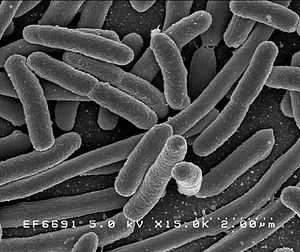Escherichia coli O104:H21
| Escherichia coli | |
|---|---|
 | |
| Scientific classification | |
| Superdomain: | Phylogenetica |
| Phylum: | Proteobacteria |
| Class: | Gamma Proteobacteria |
| Order: | Enterobacteriales |
| Family: | Enterobacteriaceae |
| Genus: | Escherichia |
| Species: | E. coli |
| Binomial name | |
| Escherichia coli T. Escherich, 1885 | |
Escherichia coli O104:H21 is a rare serotype of Escherichia coli, a species of bacteria that lives in the lower intestines of mammals.[1] The presence of many serotypes of E. coli in animals is beneficial or does not cause disease in animals. However, some serotypes of E. coli have been recognized as pathogenic to humans, e.g. E. coli O157:H7, E. coli O121 and E. coli O104:H21.
History
E. coli O104:H21 was discovered in 1982, when it caused an outbreak of severe bloody diarrhea. It had infected hamburgers, and those affected had eaten these hamburgers not fully cooked.[2]
An outbreak of E. coli responsible for at least 22 deaths in Northern Europe in May 2011 was reported to be caused by another O104 strain, Escherichia coli O104:H4.
Effects
E. coli O104:H21 can cause outbreak of infection similar to that caused by E. coli O157:H7, the most common shiga-like toxin-producing E. coli (SLTEC). SLTECs are the most well-known causes of gastrointestinal illness and diarrhea.[3]
Treatment
The body usually rids itself of harmful E. coli O104:H21 on its own within 5 to 10 days. Antibiotics should not be used, and neither should antidiarrheal agents such as loperamide.[2]
See also
References
- ↑ http://www.cdc.gov/mmwr/preview/mmwrhtml/mm5602a2.htm Laboratory-Confirmed Non-O157 Shiga Toxin Producing E. Coli, Centers for Disease Control and Prevention, accessed March 16, 2007
- ↑ 2.0 2.1 http://www.cdc.gov/ncidod/dbmd/diseaseinfo/escherichiacoli_g.htm#What%20is%20Escherichia%20coli%20O157:H7 Centers for Disease Control and Prevention, Last Accessed August 1, 2007
- ↑ http://www.cdc.gov/mmwr/preview/mmwrhtml/00038146.htm Outbreak of Acute Gastroenteritis Attributable to Escherichia coli Serotype O104:H21, Centers for Disease Control and Prevention, accessed July 31, 2007